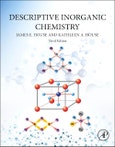House's Descriptive Inorganic Chemistry, Third Edition, provides thoroughly updated coverage of the synthesis, reactions, and properties of elements and inorganic compounds. Ideal for the one-semester (ACS-recommended) sophomore or junior level course in descriptive inorganic chemistry, this resource offers a readable and engaging survey of the broad spectrum of topics that deal with the preparation, properties, and use of inorganic materials.
Using rich graphics to enhance content and maximize learning, the book covers the chemical behavior of the elements, acid-base chemistry, coordination chemistry, organometallic compounds, and numerous other topics to provide a coherent treatment of the field. The book pays special attention to key subjects such as chemical bonding and Buckminster Fullerenes, and includes new and expanded coverage of active areas of research, such as bioinorganic chemistry, green chemistry, redox chemistry, nanostructures, and more.
Please Note: This is an On Demand product, delivery may take up to 11 working days after payment has been received.
Table of Contents
Preface 1. Where It All Comes From 2. Atomic Structure and Properties 3. Covalent Bonding and Molecular Structure 4. Ionic Bonding, Crystals, and Intermolecular Forces 5. Reactions and Energy Relationships 6. Acids, Bases, and Nonaqueous Solvents 7. Hydrogen 8 The Group IA and IIA Metals 9. Boron 10. Aluminum, Gallium, Indium, and Thallium 11. Carbon 12. Silicon, Germanium, Tin, and Lead 13. Nitrogen 14. Phosphorus, Arsenic, Antimony, and Bismuth 15 Oxygen 16. Sulfur, Selenium, and Tellurium 17. Halogens 18. The Noble Gases 19. The Transition Metals 20. Structure and Bonding In Coordination Compounds 21. Synthesis and Reactions of Coordination Compounds 22. Organometallic Compounds 23. Inorganic Substances in Biochemical Applications Appendix A Ground State Electron Configurations of Atoms Appendix B: Ionization Energies Index








